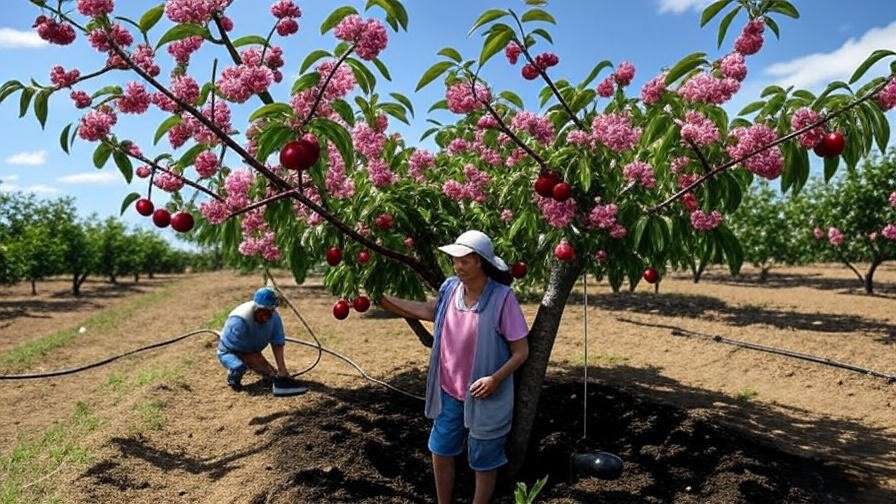Picture this: vibrant cherry blossoms bursting with color under a blazing summer sun, followed by a bountiful harvest of juicy, homegrown cherries. 🍒 Sounds like a dream, right? For gardeners in hot climates, growing cherry trees can feel like a challenge, but it’s absolutely achievable with the right strategies. Cherry tree care for hot climates: tips for thriving trees is your ultimate guide to overcoming heat-related hurdles and cultivating healthy, fruitful cherry trees. Whether you’re in USDA Zone 8, 9, or 10, this article, crafted by a horticulture expert with over a decade of experience, delivers science-backed, practical advice to ensure your cherry trees flourish. From selecting low-chill varieties to mastering watering techniques, you’ll find everything you need to succeed. Let’s dive in! 🌳
Understanding Cherry Trees in Hot Climates 🌡️
Why Hot Climates Challenge Cherry Trees
Cherry trees (Prunus avium) are traditionally associated with cooler climates, but hot regions pose unique challenges. High temperatures can stress trees, leading to reduced fruit production, sunburned bark, and excessive water loss. Most cherry varieties require a certain number of “chill hours” (hours below 45°F) to break dormancy and produce fruit. In warm climates, where chill hours are scarce, standard varieties like ‘Bing’ struggle. Additionally, intense sunlight can scorch leaves and fruit, while dry soils exacerbate stress. Understanding these challenges is the first step to successful cherry tree care for hot climates.
Benefits of Growing Cherry Trees in Warm Regions
Despite the challenges, growing cherry trees in hot climates offers incredible rewards. Their stunning spring blossoms add aesthetic charm to any garden, while homegrown cherries provide a delicious, nutrient-rich harvest. 🍒 In milder hot climates, such as coastal areas, cherry trees can thrive year-round with proper care. Plus, cultivating your own fruit reduces grocery bills and connects you with nature. With the right approach, you can turn your backyard into a cherry paradise, even under the blazing sun. 🌞
Selecting the Right Cherry Tree Varieties for Hot Climates 🌳
Low-Chill Cherry Varieties
The key to success in hot climates lies in choosing low-chill cherry varieties that require fewer than 400 chill hours. Varieties like ‘Minnie Royal,’ ‘Royal Lee,’ ‘Royal Crimson,’ and ‘Lapins’ are bred for warm regions and perform exceptionally well in USDA Zones 8–10. For example, ‘Stella’ is a self-pollinating, low-chill variety that produces sweet, dark cherries even in Southern California’s heat. When selecting trees, source saplings from reputable nurseries or trusted online suppliers like Stark Bro’s or Dave Wilson Nursery to ensure quality and disease resistance.
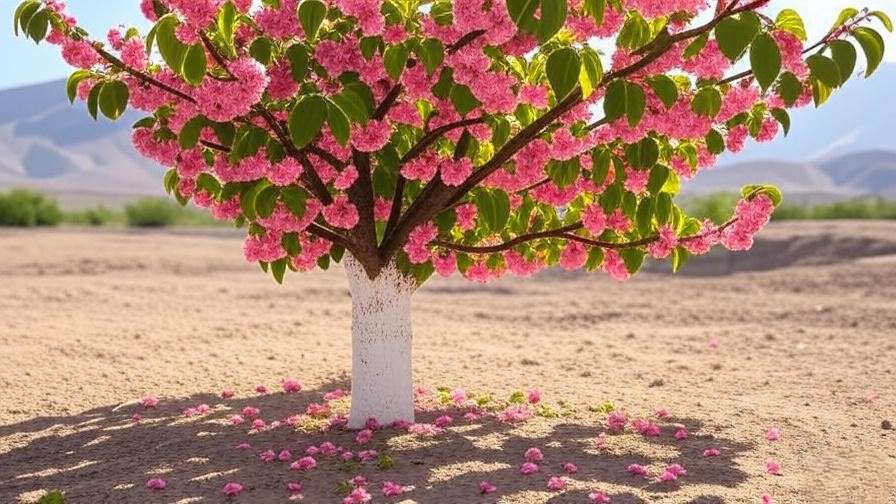
Rootstock Considerations
Rootstock plays a critical role in a cherry tree’s ability to withstand heat and drought. Opt for heat-tolerant rootstocks like Mazzard or Colt, which promote vigorous growth and resilience. Mazzard, for instance, enhances drought tolerance, while Colt supports smaller trees ideal for home gardens. Consult with your local nursery to match rootstock to your soil type and climate. Proper rootstock selection ensures your cherry trees are built to thrive in challenging conditions.
Planting Cherry Trees for Success in Hot Climates 🌱
Best Time to Plant
Timing is everything when planting cherry trees in hot climates. Late fall or early winter, when temperatures are cooler, allows roots to establish before the summer heat hits. In regions with mild winters, such as parts of Arizona or Texas, planting in November or December is ideal. Avoid spring or summer planting, as young trees are vulnerable to heat stress during establishment.
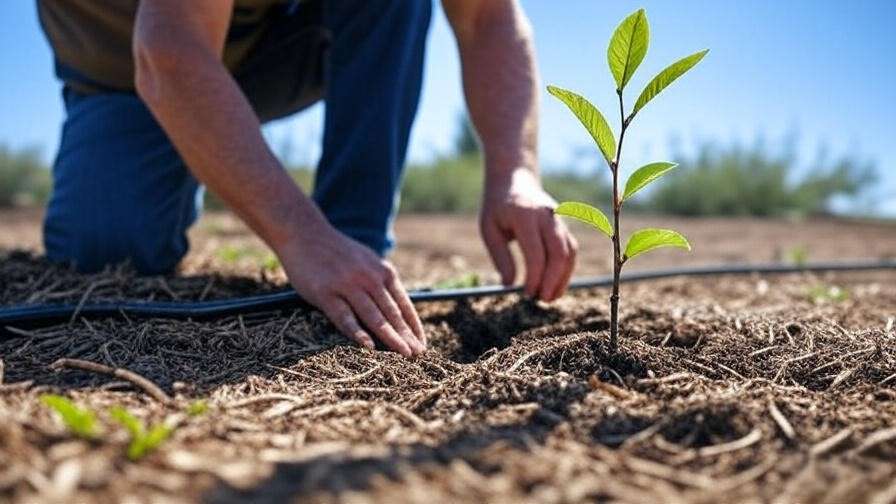
Site Selection and Preparation
Choose a planting site with partial shade to protect your cherry tree from intense afternoon sun. A spot with morning sunlight and afternoon shade is perfect. Ensure the soil is well-draining with a pH of 6.0–7.0, as cherry trees dislike waterlogged roots. Before planting, enrich the soil with organic matter like compost or aged manure to improve moisture retention. Apply a 2–4 inch layer of organic mulch, such as wood chips or straw, to regulate soil temperature and conserve water. 🌿 This step is crucial for keeping roots cool in hot climates.
Essential Care Tips for Thriving Cherry Trees ☀️
Watering Strategies for Hot Climates
Watering is the backbone of cherry tree care for hot climates. Deep, infrequent watering encourages strong root systems that can withstand drought. Aim to water 1–2 times per week, providing 10–15 gallons for young trees and up to 30 gallons for mature ones, depending on soil type. Drip irrigation systems are highly effective, delivering water directly to the root zone while minimizing evaporation. Monitor soil moisture with a simple probe or your finger—water when the top 2 inches feel dry but avoid overwatering, which can lead to root rot.
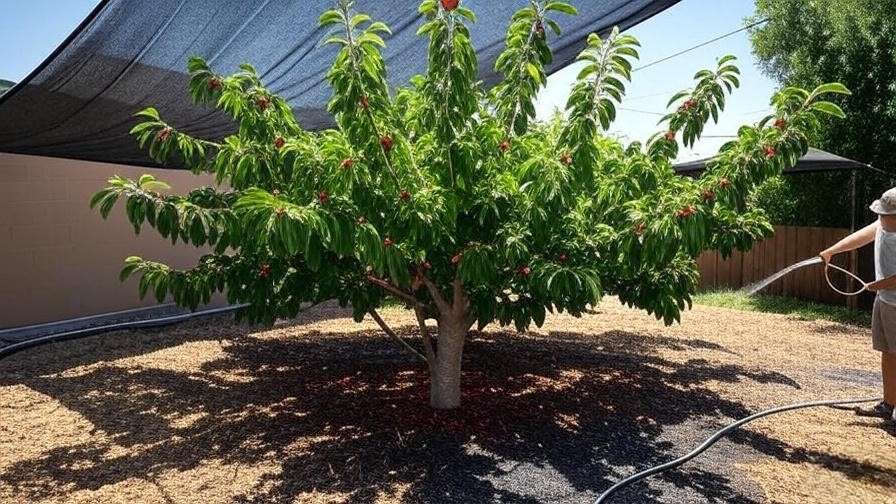
Protecting Trees from Heat Stress
Extreme heat can damage cherry trees, causing sunburn on trunks and fruit. To protect your trees, apply a white latex paint (diluted 1:1 with water) to the trunk to reflect sunlight. Alternatively, use tree wraps or shade cloth during peak summer months. Reflective mulch, such as white plastic or gravel, can also reduce soil heat. Prune trees in late winter or early spring to avoid exposing fresh cuts to intense heat, which can invite disease.
Fertilizing for Optimal Growth
Cherry trees in hot climates benefit from balanced fertilization to support growth and fruiting. Use a 10-10-10 NPK fertilizer or an organic alternative like composted manure in early spring and again after harvest. Apply 1–2 pounds of fertilizer per tree, depending on size, and water thoroughly to prevent burn. Avoid over-fertilizing, as excess nitrogen can lead to lush foliage at the expense of fruit and increase heat stress susceptibility.
Pest and Disease Management
Hot climates can exacerbate pest and disease issues. Common pests include aphids, spider mites, and cherry fruit flies, which thrive in warm weather. Use organic controls like neem oil or insecticidal soap, applied early in the morning to avoid leaf burn. Heat-related diseases, such as bacterial canker or powdery mildew, can be prevented by ensuring good air circulation through proper pruning and avoiding overhead watering. Regularly inspect your trees for signs of trouble, such as yellowing leaves or sticky residue, and act quickly to mitigate issues.
Pruning and Training Cherry Trees in Warm Regions ✂️
Pruning for Heat Adaptation
Pruning is essential for maintaining an open canopy that allows air circulation and reduces heat stress. In hot climates, prune cherry trees in late winter or early spring to shape them and remove dead or crowded branches. Aim for a modified central leader or open-center structure to maximize light penetration and airflow. Use clean, sharp tools to make precise cuts, and disinfect them between trees to prevent disease spread. Proper pruning enhances fruit quality and tree resilience.
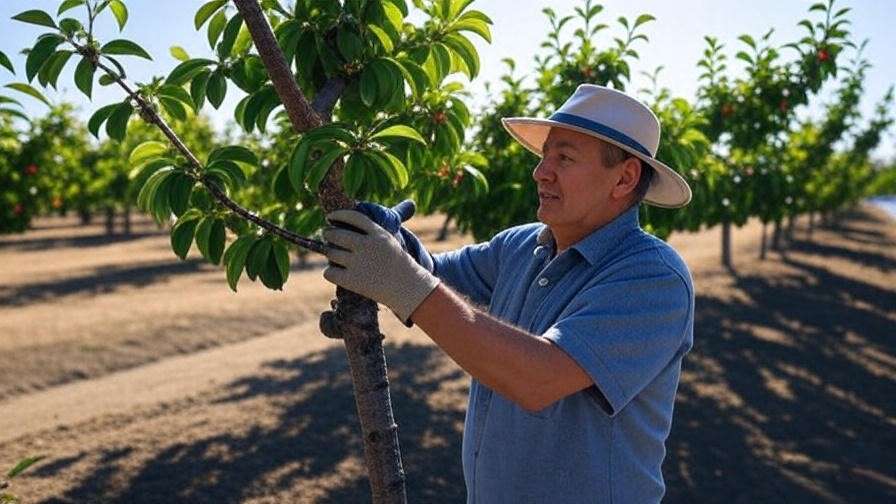
Training Young Trees
Training young cherry trees sets the stage for long-term success. For dwarf or semi-dwarf varieties, use a modified central leader system to create a strong, balanced framework. Stake young trees to protect them from wind, especially in hot, dry regions where gusts are common. Remove suckers and water sprouts regularly to focus energy on productive branches. Consistent training during the first 2–3 years ensures a sturdy, heat-tolerant tree.
Expert Tips for Maximizing Fruit Production 🍒
Pollination in Hot Climates
Pollination is critical for fruit set, and hot climates can affect pollinator activity. Many low-chill cherry varieties, like ‘Stella,’ are self-pollinating, but others, such as ‘Minnie Royal,’ require a compatible pollinator like ‘Royal Lee.’ Plant pollinator-friendly flowers, such as lavender or marigolds, nearby to attract bees. 🐝 In areas with low pollinator activity, consider hand-pollination using a small brush to transfer pollen between flowers. This technique can significantly boost yields in warm regions.
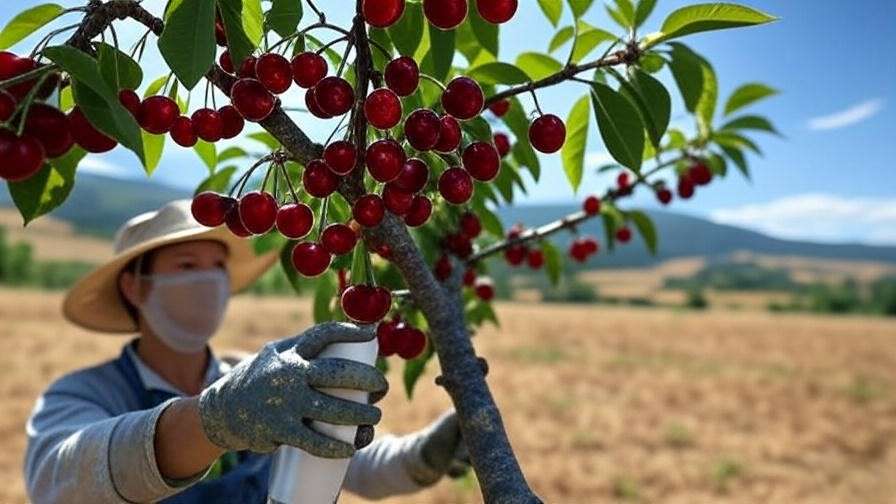
Managing Heat During Fruit Development
Protecting developing fruit from sunburn is a must in hot climates. Apply kaolin clay sprays, a natural mineral-based product, to create a protective coating on fruit and leaves. This reduces heat absorption and prevents cracking. Harvest cherries early in the morning when they’re cool and at peak flavor. Timing is key—pick fruit just as it ripens to avoid heat damage and ensure the best taste.
Real-World Examples and Success Stories 🌟
Real gardeners in hot climates have proven that cherry trees can thrive with the right techniques. Here are two inspiring examples to guide your journey:
Case Study 1: Arizona Homeowner’s ‘Lapins’ Success
In Tucson, Arizona (USDA Zone 9), a homeowner named Maria transformed her backyard into a cherry haven. Facing intense summer heat, she chose ‘Lapins,’ a low-chill, self-pollinating variety. Maria installed a drip irrigation system to deliver consistent moisture and applied a 3-inch layer of wood chip mulch to keep roots cool. To combat sunburn, she painted her tree’s trunk with diluted white latex paint. By the third year, her tree produced over 10 pounds of sweet cherries annually. Her key takeaway? “Patience and proper watering make all the difference in the desert.” 🍒
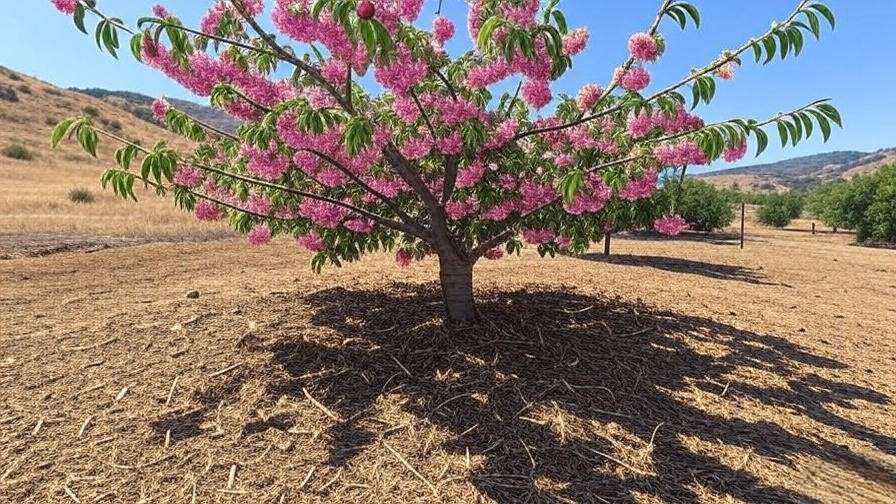
Case Study 2: Southern California Orchard Triumph
A small organic orchard in Riverside, California, boosted yields by planting ‘Royal Crimson’ and ‘Minnie Royal’ trees on Colt rootstock. The orchard manager used shade cloth during peak summer months and incorporated compost into the soil for better water retention. By attracting pollinators with native wildflowers, the orchard saw a 20% increase in fruit set. Their success highlights the importance of variety selection and pollinator support in hot climates. 🌸
These stories show that with dedication and the right strategies, cherry trees can flourish even in challenging environments.
Common Mistakes to Avoid When Growing Cherry Trees in Hot Climates 🚫
To ensure your cherry trees thrive, steer clear of these common pitfalls:
- Overwatering or Poor Drainage: Excess water leads to root rot, especially in heavy clay soils. Always check soil drainage before planting and use raised beds if necessary.
- Planting High-Chill Varieties: Varieties like ‘Bing’ or ‘Rainier’ require 800+ chill hours and will fail to fruit in warm regions. Stick to low-chill options like ‘Stella’ or ‘Royal Lee.’
- Neglecting Mulch or Shade: Without mulch or shade protection, roots overheat, and trunks suffer sunburn. A 2–4 inch mulch layer and shade cloth are non-negotiable in hot climates.
- Improper Pruning Timing: Pruning in summer exposes fresh cuts to heat and pathogens. Always prune in late winter or early spring for optimal healing.
Avoiding these mistakes sets your cherry trees up for long-term success. 🌳
FAQs About Cherry Tree Care in Hot Climates ❓
Q: Can cherry trees survive in USDA Zone 9 or 10?
A: Absolutely! Low-chill varieties like ‘Minnie Royal’ and ‘Lapins’ thrive in Zones 9 and 10 with proper care, including shade, irrigation, and mulch. 🌞
Q: How often should I water my cherry tree in summer?
A: Water deeply 1–2 times per week, providing 10–30 gallons depending on tree size and soil type. Use drip irrigation for efficiency and check soil moisture regularly.
Q: What’s the best mulch for cherry trees in hot climates?
A: Organic mulches like wood chips, straw, or bark, applied 2–4 inches deep, retain moisture and regulate soil temperature effectively.
Q: How do I protect my cherry tree from extreme heat?
A: Use shade cloth, reflective mulch, or white latex paint on trunks to reduce heat stress. Ensure consistent watering and avoid pruning during peak heat.
Q: Are there dwarf cherry trees suitable for hot climates?
A: Yes, dwarf varieties like ‘Minnie Royal’ and ‘Royal Lee’ are compact, heat-tolerant, and perfect for small gardens or containers.
Conclusion
Growing cherry trees in hot climates is not only possible but rewarding with the right approach. By selecting low-chill varieties, planting in well-prepared sites, and following expert care tips like deep watering, heat protection, and proper pruning, you can enjoy vibrant blossoms and delicious cherries. 🍒 Avoid common mistakes, stay proactive with pest and disease management, and draw inspiration from success stories like those in Arizona and California. Start planning your cherry tree garden today, and share your progress in the comments or reach out for personalized advice! 🌳 For more fruit tree tips, explore our related articles on organic pest control or drought-tolerant gardening.

